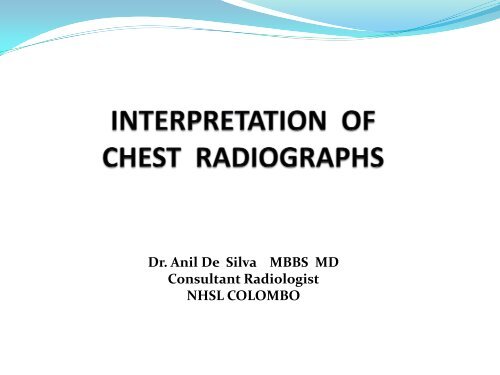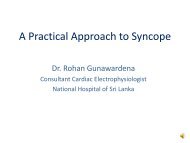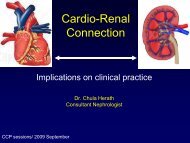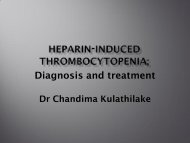Analytical evaluation of Chest X rays by Dr
Analytical evaluation of Chest X rays by Dr
Analytical evaluation of Chest X rays by Dr
Create successful ePaper yourself
Turn your PDF publications into a flip-book with our unique Google optimized e-Paper software.
<strong>Dr</strong>. Anil De Silva MBBS MD<br />
Consultant Radiologist<br />
NHSL COLOMBO
INTRODUCTION<br />
• <strong>Chest</strong> x-<strong>rays</strong> are the most frequently requesting x-ray.<br />
• Interpretation <strong>of</strong> chest x-<strong>rays</strong> are challenge to the<br />
Radiologist.<br />
• Appearances may be non-specific, with multiple<br />
differential diagnosis.<br />
• Correlation with clinical findings & investigations are<br />
important.
Areas covered are….<br />
• Normal <strong>Chest</strong> X RaY<br />
• Interpretation <strong>of</strong> abnormal <strong>Chest</strong> X Rays<br />
• CXR IN ICU
Technique<br />
• Telechest [<strong>Chest</strong> PA] Frontal CXR<br />
• 6 ft distance between xray casset and the x-ray tube [FFD]<br />
• High KV [120-150]<br />
• Deep Inspiration /Holding the breath<br />
• Centre to T6/T 7
Viewing the PA film<br />
• Check the identifying information on the film.<br />
• Clinical history is important..<br />
• Good quality X-<strong>rays</strong> must be produced.<br />
• Knowledge <strong>of</strong> the normal appearance is essential.<br />
• Comparison with old films is important.
INTERPRETATION OF CXR<br />
INVOLVES 4 BASIC STEPS<br />
• 1. Documentary information<br />
• 2. Technical consideration<br />
• 3. Detection & description <strong>of</strong><br />
abnormalities<br />
• 4 Differential diagnosis,Specific Diagnosis
Suggested Scheme OF VIEWING<br />
• Labeling X-ray no /side[correct pt/film]<br />
• Technical factors<br />
• Centering<br />
• Inspiration<br />
• Penetration[exposure]<br />
• Position
EXPIRATORY FILM
OVER PENETRATED
Viewing the <strong>Chest</strong> PA<br />
• Trachea /Carina<br />
• Lung fields<br />
• Hila / Mediastinum<br />
• Heart Pulmonary Vasculature<br />
• Hidden areas<br />
• Diaphragms - below the diaphragms<br />
• S<strong>of</strong>t tissues<br />
• Bony thorax
Suggested –Scheme <strong>of</strong> viewing<br />
• Trachea centering ,position<br />
• Carina angle 60-70<br />
• Ht,mediastinum size, shape, displacement.<br />
• Diaphragms outline,position,under the diaphragm.<br />
• Pleura<br />
• Lung fields<br />
costophrenic angle,<br />
cardiophrenic angle,<br />
fissures.<br />
comparison <strong>of</strong> both lungs.<br />
abnormality,local/generalized
Hidden areas
Pulmonary Vessels -Hilum<br />
• Lt hilum 2.5cm higher than Rt.<br />
• Hilum is formed mainly <strong>by</strong> pulmonary vessels.<br />
• Normal lymph nodes are not seen.<br />
• Lt pulmonary artery lies above the Lt main bronchustherefore<br />
higher.<br />
• Rt pulmonary artery lies anterior to Rt main bronchustherefore<br />
lower.<br />
• Maximum diameter <strong>of</strong> Rt desending pulmonary artery 10-<br />
16mm.<br />
• At the first intercostal space the diameter <strong>of</strong> vessels is<br />
HILA
ENLARGEDHILA-PULMONARY HYPERTENSION
ENLARGED HILA-LYMPHOMA
<strong>Chest</strong> xray lateral<br />
• INDICATIONS<br />
1 NODULE POORLY DEFIND IN PA<br />
VIEW.<br />
2 MEDIASTINAL MASSES.<br />
3 PLEURAL MASSES/PLAQUES.<br />
4 CARDIAC CHAMBER<br />
ENLARGEMENT.
Viewing lateral film<br />
• Air lucency over lower vertebra<br />
• Clear Spaces[behind the sternum /heart]<br />
• Diaphragm outline.<br />
• Trachea ,fissures, major vessels.
LATERAL CXRAY
MEDIASTINUM<br />
• Mediastinum is situated between the lungs in the<br />
centre <strong>of</strong> the thorax and extends from the thoracic<br />
inlet above to the diaphragm below,sternum<br />
anteriorly,spine posteriorly.<br />
• Divided into ANTERIOR,MIDDLE,POSTERIOR<br />
compartments to localize themass lesion .
Anatomy
MEDIASTINAL LESIONS
Interpretation <strong>of</strong> abnormal film.<br />
• Helpful radiological signs.<br />
• SILHOUETTE SIGN?<br />
• Permits localization <strong>of</strong> a lesion,<strong>by</strong> studing the diaphragm,<br />
heart, mediastinal borders.<br />
• Obliteration <strong>of</strong> these borders occur when the air is replaced<br />
with fluid or solid medium,<br />
• May occur with pulmonary,medistinal or pleural pathology.
Helpful signs<br />
• Air bronchogram -it shows that shadowing is<br />
intrapulmonary.<br />
• It is seen in consolidation,pulmonary oedema,hyaline<br />
membrane disease etc:
LT/LL CONSOLIDATION<br />
EFFUSION
Right upper lobe collapse
R.MID.LOBE CONSOLIDATION
R.LL.CONSOLIDATION
• Rt middle lobe lesion –obliteration <strong>of</strong> Rt heart border.<br />
• Lt lingula lobe lesion –obliteration <strong>of</strong> Lt heart border..<br />
• Apico posterior segment <strong>of</strong> Lt UL-obliteration <strong>of</strong> Aortic<br />
knukle.<br />
• Anterior segment <strong>of</strong> Rt UL,ML—obliteration <strong>of</strong> Rt aortic<br />
border
ALVEOLAR [ACINAR] SHADOWING.<br />
• Fluid filled acinus forms a 4-8mm shadow,these<br />
coalesce into ill defined,round, homogenous or patchy<br />
shadows.<br />
• Air bronchogram and silhoutte sign are characteristic<br />
features.<br />
• Eg: bat`s wing appearance in Ht<br />
failure,consolidation,I.R.D.S.
IRDS
Pulmonary oedema
PULMONARY OEDEMA
KERLEY B LINES
INTERSTITIAL PATTERN<br />
• Descriptive term and does not imply that the<br />
disease process is confined to the interstitial<br />
tissue.<br />
• In many cases both the ALVEOLAR CAVITY &<br />
INTERSTITUM are involved.<br />
• Non homogenous pattern, includes,septal<br />
lines,kerly lines,fibrosis,honeycombing,<br />
• May be mistaken for normal vascular markings.<br />
*Vessels taper and branch,<br />
*Normal vesselsare not seen in the periphery.
FIBROSING ALVEOLITIS
pPLEURAL LESION
SOLITARY PULMONARY NODULE
MULTIPLE NODULES<br />
MULTIPLE NODULES
CYSTIC BRONCHIECTASIS
L.PNEUMOTHORAX
SUPINE CXRAY PNEUMOTHORAX
PNEUMOMEDIASTINUM<br />
• CONTINUOUS DIAPHRAGM SIGN<br />
• HALO OF AIR AROUND HEART<br />
• GAS IN SOFT TISSUES<br />
• AIR AROUND PULMONARY ARTERIES AND<br />
AORTIC BRANCHES<br />
• THYMIC ANGEL WING SIGN (CHILDREN)
PNEUMOMEDIASTINUM
GAS UNDER THE DIAPHRAGM<br />
Gas under Diaphragm
ENCYSTED Encysted FLUID fluid
SUPINE Pleural CXRAY Effusion PLEURAL - Supine EFFUSION CXR
COPD<br />
• CHRONIC BRONCHITIS<br />
• CXRAY LIMITED ROLE<br />
• NORMAL CXR<br />
• OVER INFLATION<br />
• THICKENED BRONCHIAL WALLS<br />
• PERI BRONCHIAL CUFFING<br />
• AREAS OF OLIGAEMIA
EMPHYSEMA<br />
• CXR NORMAL(mild moderate)<br />
• FLAT DIAPHRAGM<br />
• VASCULAR CHANGES<br />
• BULLAE<br />
• NARROW TUBULAR HEART<br />
• PROMINENT HILAR VESSELS<br />
• THIN PERIPHERAL VESSELS.
EMPHYSEMA
EMPHYSEMA
<strong>Chest</strong> x<strong>rays</strong> in ICU<br />
•Pitfalls<br />
• Magnification <strong>of</strong> heart and mediastinum.<br />
• Rotation ,xray beam angulation,varying exposure<br />
factores,expiratory films,cause difficulties in<br />
interpretation
LUNGS IN ICU<br />
• CONSOLIDATION<br />
• COLLAPSE<br />
• INFARCTION<br />
• PLEURAL EFFUSION<br />
• PNEUMOTHORAX<br />
• ARDS,HT FAILURE
ARDS<br />
ARDS
ARDS<br />
ARDS
PULMONARY OEDEMA
CXRAY FINDINGS OF PULMONARY EMBOLISM
LINEAR & BAND SHADOWS
Limitation <strong>of</strong> plain film.<br />
• Fail to spot a lesion.<br />
• Disease may fail to appear as a visible<br />
abnormality.[Milliary .,interstitial shadows,pulmonary<br />
infarction,obstructive air way disease]<br />
• Shadow patterns are rarely specific to a single<br />
disease.[consolidation can be due to<br />
infection/infarction]
Take Home Message<br />
• Pneumonia, Tumour, Embolism – usually focal<br />
• COPD, Interstitial lung disease, heart failure – usually<br />
diffuse<br />
• For infiltrative processes, pneumonia, tumour - CXR<br />
is sensitive but not specific<br />
• For obstructive airways disease – CXR is not<br />
particularly sensitive but, can exclude complications<br />
such as pneumonia, p.thorax<br />
• For Heart failure – CXR is helpful but <strong>of</strong>ten difficult to<br />
interpret.
CT / HRCT
THANK YOU

















